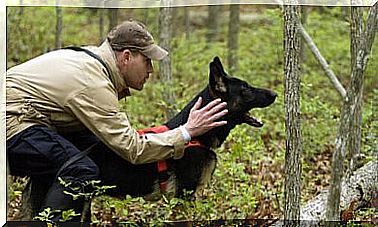How To Find Out The Origins Of A Dog With Ears

Dog breeds differ greatly from each other, so much so that it is difficult to imagine that a Great Dane and a Poodle belong to the same species. However, they are genetically identical and also have the same anatomical features. Today we know that we can uncover the origins of an eared dog.
It is clear that a dog’s ears are one of the most important parts of his anatomy. In addition to their sensory function, they express a good part of the dog’s character and personality. I n this article we reveal all the secrets of dog ears.
The origins of the dog
Gray wolves and dogs are descended from a wolf species that was extinct about 15,000 to 40,000 years ago. Science agrees on this point, but debates abound about where and when domestication began.
The event is of great historical and social interest: an animal initially feared has become the domestic companion par excellence of the human being. Fossil studies have identified evidence in various places, from southern China to Mongolia and Europe.
From these studies the hypothesis arose that the wolf may have been domesticated to become a dog more than once in different places.
The birth of dog breeds
Humans have played an important role in the creation of dog breeds in order to meet different social needs. Using rudimentary genetic engineering, the dogs were bred to accentuate a number of specific traits, through so-called artificial selection.
These processes have influenced the patterns of genetic variation. They also resulted in a higher incidence of deleterious mutations, as well as a high prevalence of hereditary diseases, which varies specifically between dog breeds.

Human intervention appears to have played a less direct role in configuring the appearance of the modern dog. Scientists, by comparing the morphology of domestic animals with their wild counterparts, have advanced the theory of “domestication syndrome”.
According to this theory, over the past hundreds of years, a wide variety of breeds have formed from the ancestral set of dog genes. As a result, domesticated animals have undergone significant morphological changes including the appearance of floppy ears.
Discover the origins of an eared dog
According to the evidence obtained from the fossil remains, at the beginning of the Bronze Age (around 4500 BC) there were already five different types of dogs:
- Mastiffs.
- Wolf dogs.
- Hunting dogs (such as the Saluki or the Greyhound).
- Pointers.
- Shepherd dogs.
Classification based on the ears
The earliest breeds had erect ears and pointed or wedge-shaped snouts, similar to those of the Nordic breeds. Today, dog ears come in many different shapes: small, long, wide or V-shaped, but they are generally classified into three main groups:
- Flexible or saggy (for example, dogs from the hound group such as the dachshund).
- Upright (e.g. West Highland White Terrier, Pinscher or Yorkshire terrier, German Shepherd or Siberian Husky).
- Semi-erect (for example, those of the Collie or Shetland sheepdog).
Check out this list of dog breeds by ear shape.
Is it genetics that determine the shape of a dog’s ears?
Several scientific studies have identified a region on chromosome 10 that possesses high levels of genetic differentiation among dog breeds. This DNA region appears to be associated with body mass and ear shape.
According to these studies, this chromosomal region contains genetic variants that affect ear type and body mass. Therefore, experts suggest that certain small mutations are responsible for these traits.

Other recent research has analyzed the genomes of 1,417 dogs corresponding to 193 breeds and 9 wild canids. Specifically, this study looked for genes that determine the shape and size of dogs’ ears.
The researchers distinguished between straight-eared breeds (101 dogs) and those with drooping ears (113 dogs) and identified a significant association between the presence of a specific gene (with regulatory function compared to other genes). and the morphology of the drooping ear.
Likewise, they were able to identify an association between the expression of two specific genes and the shape of large, round ears (for example, breeds such as the Spaniel, Beagle, and Corgi). Such genes are not present in dogs with standard-sized triangular ears (such as the Eurasier or the miniature Pinscher).
Then it is really possible to know the origins of a dog based on the ears! The genetic variability that results in the shape of your pet’s ears will no longer be a secret.









